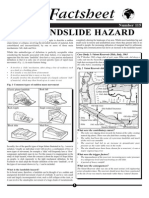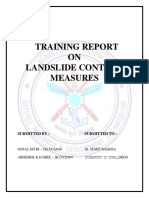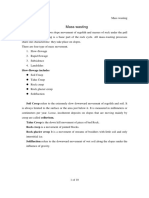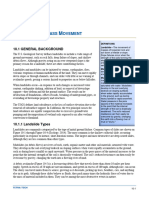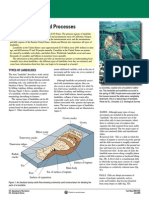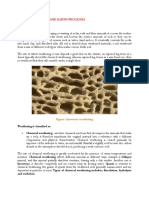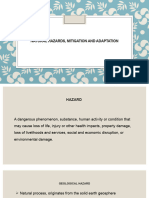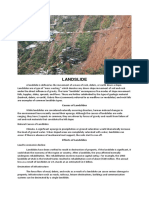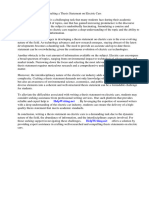Causes: Landslide
Causes: Landslide
Uploaded by
ईशान्त शर्माCopyright:
Available Formats
Causes: Landslide
Causes: Landslide
Uploaded by
ईशान्त शर्माOriginal Description:
Original Title
Copyright
Available Formats
Share this document
Did you find this document useful?
Is this content inappropriate?
Copyright:
Available Formats
Causes: Landslide
Causes: Landslide
Uploaded by
ईशान्त शर्माCopyright:
Available Formats
LANDSLIDE
A landslide or landslip is a geological phenomenon which includes a wide range of ground movement, such as rock falls, deep failure of slopes and shallow debris flows, which can occur in offshore, coastal and onshore environments. Although the action of gravity is the primary driving force for a landslide to occur, there are other contributing factors affecting the original slope stability. Typically, pre-conditional factors build up specific sub-surface conditions that make the area/slope prone to failure, whereas the actual landslide often requires a trigger before being released.
Causes
The causes of landslides are usually related to instabilities in slopes. It is usually possible to identify one or more landslide causes and one landslide trigger. The difference between these two concepts is subtle but important. The landslide causes are the reasons that a landslide occurred in that location and at that time. Landslide causes are listed in the following table, and include geological factors, morphological factors, physical factors and factors associated with human activity. Causes may be considered to be factors that made the slope vulnerable to failure, that predispose the slope to becoming unstable. The trigger is the single event that finally initiated the landslide. Thus, causes combine to make a slope vulnerable to failure, and the trigger finally initiates the movement. Landslides can have many causes but can only have one trigger as shown in the next figure. Usually, it is relatively easy to determine the trigger after the landslide has occurred (although it is generally very difficult to determine the exact nature of landslide triggers ahead of a movement event).
Main article: Causes of landslides
The Mameyes Landslide, in barrio Tibes, Ponce, Puerto Rico, which buried more than 100 homes, was caused by extensive accumulation of rains and, according to some sources, lightning. Landslides occur when the stability of a slope changes from a stable to an unstable condition. A change in the stability of a slope can be caused by a number of factors, acting together or alone. Natural causes of landslides include:
groundwater (porewater) pressure acting to destabilize the slope
Loss or absence of vertical vegetative structure, soil nutrients, and soil structure (e.g. after a wildfire) erosion of the toe of a slope by rivers or ocean waves weakening of a slope through saturation by snowmelt, glaciers melting, or heavy rains earthquakes adding loads to barely-stable slope earthquake-caused liquefaction destabilizing slopes volcanic eruptions
landslides are aggravated by human activities, Human causes include:deforestation, cultivation and construction, which destabilize the already fragile slopes
vibrations from machinery or traffic blasting earthwork which alters the shape of a slope, or which imposes new loads on an existing slope in shallow soils, the removal of deep-rooted vegetation that binds colluvium to bedrock Construction, agricultural or forestry activities (logging) which change the amount of water which infiltrates the soil.
Geological causes
Weak materials Sensitive materials Weathered materials Sheared materials Jointed or fissured materials Adversely orientated discontinuities Permeability contrasts Material contrasts Rainfall and snow fall
[edit] Morphological causes
Slope angle Uplift Rebound Fluvial erosion Wave erosion Glacial erosion Erosion of lateral margins Subterranean erosion Slope loading Vegetation change Erosion Erosion
[edit] Physical causes
Intense rainfall Rapid snow melt
Prolonged precipitation Rapid drawdown Earthquake Volcanic eruption Thawing Freeze-thaw Ground water changes Soil pore water pressure Surface runoff Seismic activity
[edit] Human causes
Excavation Loadin Drawdown Land use change Water management Mining Quarrying Vibration Water leakage Deforestation Yodeling
PREVENTIVE MEASURES
The first cause listed is gravity. Since we cannot alter gravity, what we can do, is alter geometry of the man-made slope so that the gravity effects are not detrimental. If the landslide is surficial (not too deep), the easiest way to prevent the fall of rocks and soil over the slope is to vegetate it! However, vegetation can help only if the movement hasnt already begun or if the landslide is deep! Groundwater table changes are the most common cause of landslides. Heavy rains, leaking pipes, melting of snow in warm weather, floods, etc can cause changes in the groundwater table, thus inducing a landslide. Although natural phenomena such as heavy rains, melting snow, etc cannot be modified, its effect on the groundwater table can be controlled by applying the principles of hydrology and geotechnical engineering. Rain water or snow melt can be directed far away from the slopes by building drainage channels or swales that convey the water where it shall not be detrimental to the stability of the slope. Leaking pipes or leaking swimming pools can be easily fixed, once the location of the leak is determined.
(Courtsey BBC News) Earthquakes cause ground shaking which may directly lead to a landslide. Or, the ground shaking may cause the soil to loosen and become weak, leading to a landslide. To prevent earthquake induced landslides, the ideal solution is to design the geometry of the slope such that it has an adequate factor of safety even for seismic cases.
(Courtsey Emergency Management Australia) To prevent landslides triggered due to construction on top of the slope, a setback distance should be maintained between the top of slope and construction. The distance will depend on the type of construction and geology and geometry of the slope
You might also like
- Discrete Mathematical Structures With Applications To Computer Science by J.P. Tremblay, R. Manohar PDFDocument510 pagesDiscrete Mathematical Structures With Applications To Computer Science by J.P. Tremblay, R. Manohar PDFPawan Kumar Pulivarthi61% (112)
- DRRR PPT 1Document34 pagesDRRR PPT 1Kim Estrebella0% (1)
- Analyze The Causes of Geological HazardDocument13 pagesAnalyze The Causes of Geological HazardDaniel Arradaza100% (1)
- anwarDocument4 pagesanwarabush162223No ratings yet
- Causes of LandslidesDocument8 pagesCauses of LandslideskarlaNo ratings yet
- DRRR - Module 06 (Other Related Heological Hazards)Document10 pagesDRRR - Module 06 (Other Related Heological Hazards)elesis67% (3)
- What Is A Landslide?Document10 pagesWhat Is A Landslide?Muhammad MuneerNo ratings yet
- LandslidesDocument16 pagesLandslidesk2v1n567% (3)
- AUMiT CH-5Document19 pagesAUMiT CH-5thuw83774No ratings yet
- Chapter 1Document34 pagesChapter 1gagana sNo ratings yet
- Landslide, landslip and mass watingDocument5 pagesLandslide, landslip and mass watingSudipa ShresthaNo ratings yet
- LandslideDocument43 pagesLandslideAmit SrivastavaNo ratings yet
- Causes of Geologic HazardsDocument5 pagesCauses of Geologic HazardsANTON GABRIEL PRECIOSONo ratings yet
- Debris Flow: Carlos Sebastián Echevarría ZúñigaDocument49 pagesDebris Flow: Carlos Sebastián Echevarría ZúñigaCarlos Sebastián Echevarría ZúñigaNo ratings yet
- CONCEPT NOTES 10 Exogenic ProcessDocument7 pagesCONCEPT NOTES 10 Exogenic ProcessClarissa MontoyaNo ratings yet
- DRRR-week9Document15 pagesDRRR-week9Zheniceby CabuetelaNo ratings yet
- Es ProjectDocument5 pagesEs ProjectRoshan zameerNo ratings yet
- 7 Other Related Geological HazardsDocument9 pages7 Other Related Geological HazardsJboy MnlNo ratings yet
- Table of Contents / OutlineDocument18 pagesTable of Contents / OutlineCecilio Chito Rosos TancincoNo ratings yet
- Causes of LandslidesDocument6 pagesCauses of LandslidesAizat ArifNo ratings yet
- Landslides Causes EffectsDocument9 pagesLandslides Causes EffectsDaljeet Sidhu100% (1)
- 7Document13 pages7Paulo MontesNo ratings yet
- Soil Errosion'Document24 pagesSoil Errosion'prathaNo ratings yet
- NDMM ImpDocument51 pagesNDMM Impkarthik manikantaNo ratings yet
- 115 Landslide Hazard PDFDocument5 pages115 Landslide Hazard PDFong0625No ratings yet
- Landslide Hazard InformationDocument8 pagesLandslide Hazard Informationgloria tolentino100% (1)
- Training Report ON Landslide Control Measures: Submitted By: Submitted ToDocument47 pagesTraining Report ON Landslide Control Measures: Submitted By: Submitted ToabhishekNo ratings yet
- Landslides White GM309Document22 pagesLandslides White GM309rehmania78644No ratings yet
- Mass WastingDocument10 pagesMass WastingAbhinav RajeevanNo ratings yet
- Soil Erosion - WikipediaDocument109 pagesSoil Erosion - WikipediaNnamdi EmmanuelNo ratings yet
- LANDSLIDEDocument23 pagesLANDSLIDEkereysha daradalNo ratings yet
- Module SCI101 EARTH SCI MASS WASTINGDocument9 pagesModule SCI101 EARTH SCI MASS WASTINGsm6553151No ratings yet
- Writing A Concept PaperDocument64 pagesWriting A Concept PaperJhedyl LambayanNo ratings yet
- Landslide: Parts of A Typical SlideDocument14 pagesLandslide: Parts of A Typical SlideShuvanjan Dahal100% (4)
- Clastic SedimentDocument5 pagesClastic SedimentAnonymous sokvZpFPNo ratings yet
- Physical Processes: Rainfall and Surface RunoffDocument11 pagesPhysical Processes: Rainfall and Surface RunoffKeme DoraNo ratings yet
- Soil Erosion PDFDocument20 pagesSoil Erosion PDFAja FightingNo ratings yet
- Land Slides: Dr. Adnan Khan Department of Geology University of KarachiDocument30 pagesLand Slides: Dr. Adnan Khan Department of Geology University of KarachiAmna SadiqNo ratings yet
- Earthquake Hazards: GroundshakingDocument3 pagesEarthquake Hazards: GroundshakingHannah Andrea LaparanNo ratings yet
- LandslidesDocument7 pagesLandslidesMarysha Ariel TatumNo ratings yet
- Geological HazardsDocument29 pagesGeological Hazardsangelica petronaNo ratings yet
- Santa Clara County Operational Area Hazard Mitigation Plan - Vol 1 - Part 2Document176 pagesSanta Clara County Operational Area Hazard Mitigation Plan - Vol 1 - Part 2Julimar CabayaNo ratings yet
- DRR Q2 MOD 1&2Document9 pagesDRR Q2 MOD 1&2Arnaly Barde Villarin AlayonNo ratings yet
- Malin LandslideDocument11 pagesMalin Landslideankur hulawaleNo ratings yet
- Usgs LandslidesDocument4 pagesUsgs Landslidesapi-261914272100% (1)
- Avalanches, LandslidesDocument20 pagesAvalanches, LandslidesmeenakshiNo ratings yet
- 5.1. Weathering: Chapter 5: Surface and Earth ProcessesDocument15 pages5.1. Weathering: Chapter 5: Surface and Earth ProcessesdaniNo ratings yet
- Mass WastingDocument9 pagesMass WastingLolly PopNo ratings yet
- Landslide Type PDFDocument4 pagesLandslide Type PDFAdika SeptiantoNo ratings yet
- Earthquake - Induced Landslides and TsunamisDocument16 pagesEarthquake - Induced Landslides and TsunamisJose BautistaNo ratings yet
- EST Report 51Document13 pagesEST Report 51Rohit GadekarNo ratings yet
- Chapter 3Document45 pagesChapter 3Duane AlfelorNo ratings yet
- Geologic HazardDocument6 pagesGeologic Hazardchloudchloecanta8No ratings yet
- Landslide: Causes of LandslidesDocument3 pagesLandslide: Causes of LandslidesJay R ChivaNo ratings yet
- Lect Landslide Mar - 2k11Document55 pagesLect Landslide Mar - 2k11Nk Agarwal100% (1)
- DRRD Second Quarter NotesDocument17 pagesDRRD Second Quarter NotesNicolle P. PelagioNo ratings yet
- Lesson 3.1 Geological HazardsDocument51 pagesLesson 3.1 Geological Hazardsrandyturajr21No ratings yet
- RyanDocument3 pagesRyanJan Reinhart PerezNo ratings yet
- A Brief Explanation of LandslideDocument2 pagesA Brief Explanation of LandslideturnerzzzzNo ratings yet
- Landslides Dictionary - Natural Disasters: Grow Your VocabularyFrom EverandLandslides Dictionary - Natural Disasters: Grow Your VocabularyNo ratings yet
- 5 - Study of Automatic Traffic Signal System For Chandigarh PDFDocument8 pages5 - Study of Automatic Traffic Signal System For Chandigarh PDFईशान्त शर्माNo ratings yet
- Approvable Non-Programmable Calculator List - 2014Document1 pageApprovable Non-Programmable Calculator List - 2014ईशान्त शर्माNo ratings yet
- 5 - Study of Automatic Traffic Signal System For Chandigarh PDFDocument8 pages5 - Study of Automatic Traffic Signal System For Chandigarh PDFईशान्त शर्माNo ratings yet
- CubeDocument12 pagesCubeईशान्त शर्माNo ratings yet
- Patch Work: Patching With Base RepairDocument6 pagesPatch Work: Patching With Base Repairईशान्त शर्माNo ratings yet
- AirportDocument23 pagesAirportईशान्त शर्माNo ratings yet
- Flue-Gas Stack: From Wikipedia, The Free EncyclopediaDocument6 pagesFlue-Gas Stack: From Wikipedia, The Free Encyclopediaईशान्त शर्माNo ratings yet
- #5 Chimneys: The Engine of The SystemDocument4 pages#5 Chimneys: The Engine of The Systemईशान्त शर्मा100% (2)
- RepairDocument22 pagesRepairईशान्त शर्मा100% (1)
- ASP Advt 2014 Sept17 - 04 - v3Document5 pagesASP Advt 2014 Sept17 - 04 - v3ईशान्त शर्माNo ratings yet
- Step 1: Start Step 2: Take 3 Inputs A, B and C Step 3: Add A, B, C and Store It in D Step 4: Print D Step 5: StopDocument1 pageStep 1: Start Step 2: Take 3 Inputs A, B and C Step 3: Add A, B, C and Store It in D Step 4: Print D Step 5: Stopईशान्त शर्माNo ratings yet
- Database Format - 2015Document12 pagesDatabase Format - 2015ईशान्त शर्माNo ratings yet
- Associate Software EngineerDocument1 pageAssociate Software Engineerईशान्त शर्माNo ratings yet
- Notice Inviting Application For Graduate Engineer TraineesDocument2 pagesNotice Inviting Application For Graduate Engineer Traineesईशान्त शर्माNo ratings yet
- Manoj FceDocument27 pagesManoj Fceईशान्त शर्माNo ratings yet
- Step 1: Start Step 2: Take Inputs A, B and C Step 3: Add A, B, C and Divide by 3 and Store It in D Step 4: Print D Step 5: StopDocument1 pageStep 1: Start Step 2: Take Inputs A, B and C Step 3: Add A, B, C and Divide by 3 and Store It in D Step 4: Print D Step 5: Stopईशान्त शर्माNo ratings yet
- Major Project Report: Ashish KumarDocument35 pagesMajor Project Report: Ashish Kumarईशान्त शर्माNo ratings yet
- Lec 15 Ch8 Pp295 Signal TimingDocument14 pagesLec 15 Ch8 Pp295 Signal Timingईशान्त शर्माNo ratings yet
- Step 1: Start Step 2: take input r Step 3: multiply square of r with π and store it in A Step 4: print A Step 5: stopDocument1 pageStep 1: Start Step 2: take input r Step 3: multiply square of r with π and store it in A Step 4: print A Step 5: stopईशान्त शर्माNo ratings yet
- Step 1: Start Step 2: Take Input A Step 3: Square A and Store It in D Step 4: Cube A and Store It in C Step 5: Print D and C Step 6: StopDocument1 pageStep 1: Start Step 2: Take Input A Step 3: Square A and Store It in D Step 4: Cube A and Store It in C Step 5: Print D and C Step 6: Stopईशान्त शर्माNo ratings yet
- K Expansive SoilsDocument18 pagesK Expansive Soilsईशान्त शर्मा100% (1)
- Types of WallsDocument17 pagesTypes of WallsKiranNo ratings yet
- Report Annual Human Rights Report 2012 EngDocument110 pagesReport Annual Human Rights Report 2012 Engsaon_ewuNo ratings yet
- Dolphin IniDocument3 pagesDolphin IniAsmana100% (1)
- Comparative Anatomy Exam: C. Blue Mackerel ScadDocument4 pagesComparative Anatomy Exam: C. Blue Mackerel ScadflowenceNo ratings yet
- List of Companies CompressDocument152 pagesList of Companies CompressmashurfaceNo ratings yet
- DNV Offshore Substation SafetyDocument12 pagesDNV Offshore Substation Safetytkdrt2166No ratings yet
- SBI FASTag Application Form - Minimum KYCDocument2 pagesSBI FASTag Application Form - Minimum KYCDev Printing SolutionNo ratings yet
- 3) Figures To The Right Indicates Full Marks of The QuestionDocument2 pages3) Figures To The Right Indicates Full Marks of The QuestionUjjval SolankiNo ratings yet
- HW 2 Solutions: P Good Oil P (Oil) P Oil P Oil Dy P (Dry)Document5 pagesHW 2 Solutions: P Good Oil P (Oil) P Oil P Oil Dy P (Dry)Ali AlQattanNo ratings yet
- World Famous Parabolic ArchesDocument11 pagesWorld Famous Parabolic ArchesRaphael Estenzo OrionNo ratings yet
- IgnitionDocument26 pagesIgnitionRyan ActonNo ratings yet
- KDI 1903M - KDI 2504M: Owner ManualDocument44 pagesKDI 1903M - KDI 2504M: Owner ManualJosko Prnjak100% (1)
- Final Project On BluedartDocument70 pagesFinal Project On Bluedartbalaji shanmugamNo ratings yet
- RMB 22 - 37 KW RMB IVR 22 - 37 KW: Solid, Simple, Smart: Advanced Reliability in Compressed AirDocument6 pagesRMB 22 - 37 KW RMB IVR 22 - 37 KW: Solid, Simple, Smart: Advanced Reliability in Compressed AirRUDRA MORENo ratings yet
- BMW 1er 116d M SportDocument11 pagesBMW 1er 116d M SportCristescu IsaNo ratings yet
- 0545fevaluation of Channel MembersDocument15 pages0545fevaluation of Channel MembersChetan PahwaNo ratings yet
- Salient Features CarlDocument6 pagesSalient Features CarlNazareneJoyNo ratings yet
- Software Programming Guide - v2.0Document11 pagesSoftware Programming Guide - v2.0Mitica ScurtuNo ratings yet
- 6 Night 7 Days East Europe PackageDocument7 pages6 Night 7 Days East Europe PackageAkshit ShekharNo ratings yet
- Land Rover Evoque - List of Awards - With LinksDocument3 pagesLand Rover Evoque - List of Awards - With LinksJammieNo ratings yet
- AIMO 2019 Trial S3Document7 pagesAIMO 2019 Trial S3Jomar EjedioNo ratings yet
- MCQ Geography 2Document34 pagesMCQ Geography 2Harshwardhan UndeNo ratings yet
- Thesis Statement Electric CarsDocument6 pagesThesis Statement Electric Carsexuhszief100% (1)
- How To Steal A Million - BPDocument1 pageHow To Steal A Million - BPmedamze21No ratings yet
- Phoenix Petroleum Philippines, Inc. Mail - Hedge Quotation For April 4-7Document15 pagesPhoenix Petroleum Philippines, Inc. Mail - Hedge Quotation For April 4-7Jamie HendrixNo ratings yet
- Paper GHS formENDocument4 pagesPaper GHS formENF RNo ratings yet
- MODIFIED CAD CAM - 4year 1sem PDFDocument56 pagesMODIFIED CAD CAM - 4year 1sem PDFSatya AruntejaNo ratings yet
- Johan de Meij - Canticles (Piano)Document28 pagesJohan de Meij - Canticles (Piano)Tetsuo KagehiraNo ratings yet
- Mba ProjectDocument58 pagesMba ProjectyudhishtherNo ratings yet
























